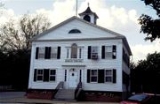
Brooklyn Green Historic District
Encyclopedia
Brooklyn Green Historic District is a historic district on Route 169
, Route 205, U.S. Route 6, Wolf Den, Brown, Prince Hill, and Hyde Roads in the town of Brooklyn, Connecticut
. The district is notable for its Greek Revival
, Colonial, and Federal architecture. It was added to the National Register of Historic Places in 1982.
The district has significance as an illustration of certain broad patterns of development in Connecticut, for its collection of architecture, and for its association with historically important individuals.
The centerpiece of the district is the Brooklyn Green, a 1.75 acres (7,082 m²) village green
in the center of the town. The Green is roughly a square bounded on four sides by streets. There are also two streets cutting across diagonally, resulting in four separate triangular sections. The eastern triangle contains the Brooklyn Meeting House. The area around the Green contains various important town buildings, including the town hall, town library, two churches (Trinity Episcopal and Federated Church of Christ), and several historic residences dating from the mid-18th century. The roads around the Green are Route 169
on the east, Putnam Place on the north and west, Brooklyn Common on the south. The diagonal streets are Wolf Den Road (northwest to southeast) and U.S. Route 6 (northeast to southwest).
The Green's adjacent buildings were photographed in the Historic American Buildings Survey
program. A HABS summary is:
Route 169 (Connecticut)
Route 169 is a state highway in the U.S. states of Connecticut and Massachusetts. It begins in the city of Norwich and runs through Northeastern Connecticut, continuing across the state line into Southbridge, Massachusetts. The route ends in Charlton after another nine miles...
, Route 205, U.S. Route 6, Wolf Den, Brown, Prince Hill, and Hyde Roads in the town of Brooklyn, Connecticut
Brooklyn, Connecticut
Brooklyn is a town in Windham County, Connecticut, United States. The population was 7,173 at the 2000 census. The town center village is listed by the U.S. Census Bureau as a census-designated place...
. The district is notable for its Greek Revival
Greek Revival architecture
The Greek Revival was an architectural movement of the late 18th and early 19th centuries, predominantly in Northern Europe and the United States. A product of Hellenism, it may be looked upon as the last phase in the development of Neoclassical architecture...
, Colonial, and Federal architecture. It was added to the National Register of Historic Places in 1982.
The district has significance as an illustration of certain broad patterns of development in Connecticut, for its collection of architecture, and for its association with historically important individuals.
The centerpiece of the district is the Brooklyn Green, a 1.75 acres (7,082 m²) village green
Village green
A village green is a common open area which is a part of a settlement. Traditionally, such an area was often common grass land at the centre of a small agricultural settlement, used for grazing and sometimes for community events...
in the center of the town. The Green is roughly a square bounded on four sides by streets. There are also two streets cutting across diagonally, resulting in four separate triangular sections. The eastern triangle contains the Brooklyn Meeting House. The area around the Green contains various important town buildings, including the town hall, town library, two churches (Trinity Episcopal and Federated Church of Christ), and several historic residences dating from the mid-18th century. The roads around the Green are Route 169
Route 169 (Connecticut)
Route 169 is a state highway in the U.S. states of Connecticut and Massachusetts. It begins in the city of Norwich and runs through Northeastern Connecticut, continuing across the state line into Southbridge, Massachusetts. The route ends in Charlton after another nine miles...
on the east, Putnam Place on the north and west, Brooklyn Common on the south. The diagonal streets are Wolf Den Road (northwest to southeast) and U.S. Route 6 (northeast to southwest).
The Green's adjacent buildings were photographed in the Historic American Buildings Survey
Historic American Buildings Survey
The Historic American Buildings Survey , Historic American Engineering Record , and Historic American Landscapes Survey are programs of the National Park Service established for the purpose of documenting historic places. Records consists of measured drawings, archival photographs, and written...
program. A HABS summary is:
Little altered since the mid-nineteenth century, Brooklyn Green is significant as a small, rural area that still retains much of its eighteenth- and nineteenth-century material heritage. The physical organization of the area reflects the historical development of the town and the region, including its growth in the first half of the nineteenth century and decline in the decades that followed. Many of the buildings and structures located near the Brooklyn Green are architecturally significant, exemplifying the styles that were popular between 1750 and 1850, the area's period of greatest significance. Finally, some of the buildings and structures are associated with the lives of prominent individuals in Brooklyn history, including Israel Putnam (1718-1790) and Daniel Tyler, Jr. (ca. 1700-1800).
External links
- Brooklyn Green, North Green, South Green, & West Green, parts of B, Brooklyn, Windham County, CT: 17 photos, at Historic American Building Survey

